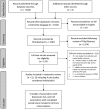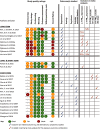Air Pollution (Particulate Matter) Exposure and Associations with Depression, Anxiety, Bipolar, Psychosis and Suicide Risk: A Systematic Review and Meta-Analysis
- PMID: 31850801
- PMCID: PMC6957283
- DOI: 10.1289/EHP4595
Air Pollution (Particulate Matter) Exposure and Associations with Depression, Anxiety, Bipolar, Psychosis and Suicide Risk: A Systematic Review and Meta-Analysis
Abstract
Background: Particulate air pollution's physical health effects are well known, but associations between particulate matter (PM) exposure and mental illness have not yet been established. However, there is increasing interest in emerging evidence supporting a possible etiological link.
Objectives: This systematic review aims to provide a comprehensive overview and synthesis of the epidemiological literature to date by investigating quantitative associations between PM and multiple adverse mental health outcomes (depression, anxiety, bipolar disorder, psychosis, or suicide).
Methods: We undertook a systematic review and meta-analysis. We searched Medline, PsycINFO, and EMBASE from January 1974 to September 2017 for English-language human observational studies reporting quantitative associations between exposure to PM in aerodynamic diameter (ultrafine particles) and PM and in aerodynamic diameter ( and , respectively) and the above psychiatric outcomes. We extracted data, appraised study quality using a published quality assessment tool, summarized methodological approaches, and conducted meta-analyses where appropriate.
Results: Of 1,826 citations identified, 22 met our overall inclusion criteria, and we included 9 in our primary meta-analyses. In our meta-analysis of associations between long-term () exposure and depression ( studies), the pooled odds ratio was 1.102 per increase (95% CI: 1.023, 1.189; ). Two of the included studies investigating associations between long-term exposure and anxiety also reported statistically significant positive associations, and we found a statistically significant association between short-term exposure and suicide in meta-analysis at a 0-2 d cumulative exposure lag.
Discussion: Our findings support the hypothesis of an association between long-term exposure and depression, as well as supporting hypotheses of possible associations between long-term exposure and anxiety and between short-term exposure and suicide. The limited literature and methodological challenges in this field, including heterogeneous outcome definitions, exposure assessment, and residual confounding, suggest further high-quality studies are warranted to investigate potentially causal associations between air pollution and poor mental health. https://doi.org/10.1289/EHP4595.
Figures






Comment in
-
Schlechte Luft, miese Stimmung : Depression.MMW Fortschr Med. 2020 May;162(9):26-27. doi: 10.1007/s15006-020-0463-2. MMW Fortschr Med. 2020. PMID: 32405853 Free PMC article. Review. German.
References
-
- Allen JL, Liu X, Pelkowski S, Palmer B, Conrad K, Oberdörster G, et al. . 2014. Early postnatal exposure to ultrafine particulate matter air pollution: persistent ventriculomegaly, neurochemical disruption, and glial activation preferentially in male mice. Environ Health Perspect 122(9):939–945, PMID: 24901756, 10.1289/ehp.1307984. - DOI - PMC - PubMed
-
- Armijo-Olivo S, Stiles CR, Hagen NA, Biondo PD, Cummings GG. 2012. Assessment of study quality for systematic reviews: a comparison of the Cochrane Collaboration Risk of Bias Tool and the Effective Public Health Practice Project Quality Assessment Tool: methodological research. J Eval Clin Pract 18(1):12–18, PMID: 20698919, 10.1111/j.1365-2753.2010.01516.x. - DOI - PubMed
Publication types
MeSH terms
Substances
Grants and funding
LinkOut - more resources
Full Text Sources
Medical
Miscellaneous
